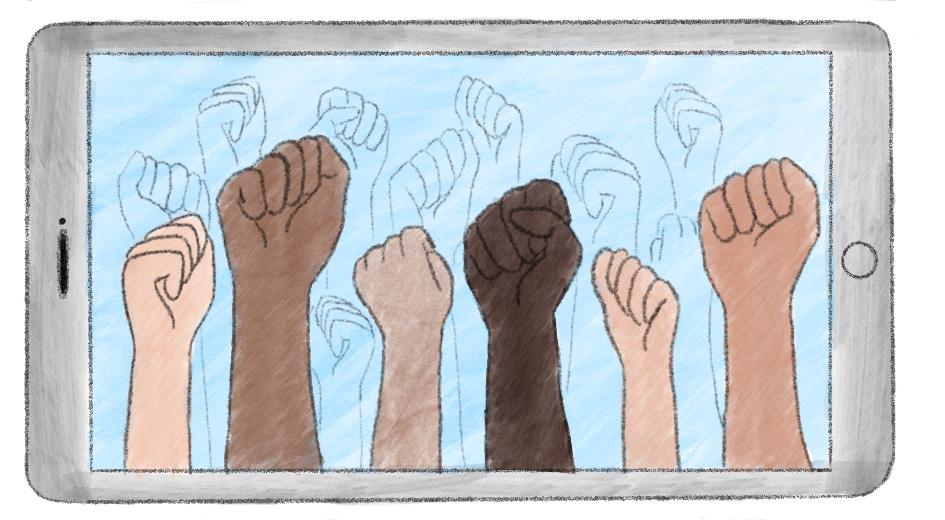When Western media remained largely silent about the brutality and devastation of Israel’s war on Gaza, Gen Z picked up their phones and filled the information gap the former left behind.
TikTok videos of bombed streets, Instagram reels about occupation, and emotional statements spread across social media feeds. This is more than passive scrolling; it’s digital resistance.
For Gen Z, social media platforms have evolved beyond the latest trending posts and aesthetic photos—they’ve become a political platform on a massive scale. Young people are using their digital skills to challenge Western narratives, call for action, and raise awareness about global issues in regions such as Palestine, Sudan, and Lebanon, to name a few.
With Egypt being situated geographically as a corner point, the proximity heightens the need to be actively engaged in digital advocacy through organizing protests and awareness posters on campus.
Mohamed Touni, a senior political science student who participated in a university-wide Palestine solidarity protest back in October 2024, thinks traditional media outlets such as CNN are no longer the go-to source of news for Gen Z but rather have been replaced with Instagram and TikTok, allowing them to create their own narratives.
“We wanted to push back against the algorithm and platform censorship and make sure our protest was visible on social media,” he told The Caravan.
A 30-second TikTok can easily explain dense political events, while an Instagram carousel post can distill an entire article into a visually digestible format.
“I learned more about what’s happening in Palestine from TikTok than I ever did in class,” says Alya Amer, a graduating Integrated Marketing Communications (IMC) senior at AUC. “It’s unfiltered. You hear it directly from people living it.”
The ease of sharing all boils down to the click of one button, but with this spotlight on underrepresented issues comes a larger issue at hand: censorship.
Khadija Gamal, a student at Parsons New York and an active digital activist for Palestine on Instagram, said, “In a single week, I had five stories taken down. All I did was post photos from Gaza.”
She added that her posts related to political movements receive only 15 percent of the views she gets for non-political content.
Mathew Hendershot, Associate Dean of Undergraduate Studies and the Academy of Liberal Arts at AUC, and founder of Cultural Catalyst Consulting, a firm focused on resolving multicultural and multinational conflicts in war-affected regions, offered a critical perspective on the limits of digital engagement.
“Gen Z’s form of activism now is clicking, liking, or forwarding, which in reality, does very little,” he said.
“If you go back a couple of decades, AUC students rallied together and raised funds for resources and medical supplies. That was real, tangible activism.”
According to Hendershot, Gen Z’s digital protests have created what he views as a false sense of what activism truly is. He emphasized that these global issues are far more complex than what can be communicated in a 30-second video.
On social media, nuance is often lost, and the issues are simplified.
The limitations of social media algorithms contribute to this problem. A 2022 CNN investigation revealed that TikTok’s search feature quickly surfaced misinformation related to elections, vaccines, and global conflicts, even when users entered neutral or factual search terms.
Despite these challenges, digital activism can still be quite impactful, says Shahira Fahmy, a research scholar and professor in the Department of Journalism and Mass Communication.
“Social media gives Gen Z a space to express their views and catalyze action because it is accessible and can rapidly reach a vast audience. For example, during the ongoing genocide in Gaza, young activists have utilized these platforms to document atrocities, share personal experiences, and raise awareness about systemic racism and apartheid,” she says.
When asked about the limitation of digital activism, Fahmy believes that while it may not always fit the traditional mold of activists, such as marching in the streets or organizing rallies, it plays a crucial role in reach- ing and engaging individuals, particularly those who might not typically participate in activism.
She points to the #MeToo movement having gained immense traction online.
“Digital activism can serve as a stepping stone to more conventional forms of protest. It educates and builds a community of supporters who can mobilize for offline action whenever they choose,” she says.
“Whether it’s tweeting about the genocide in Gaza or sharing a video that highlights the necessity for reform in the #MeToo movement, digital activism is undeniably a valid and essential form of action in today’s society”.
